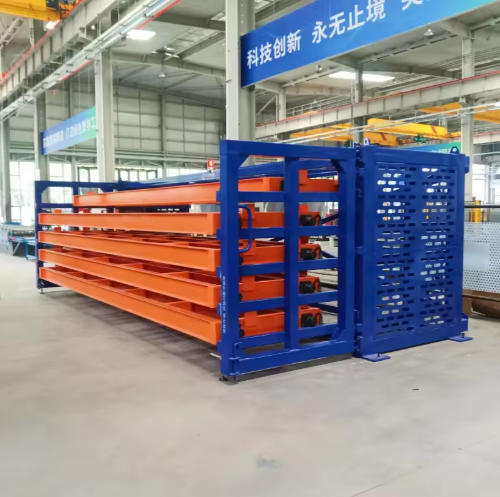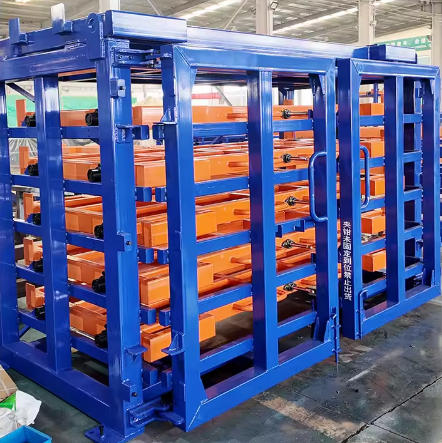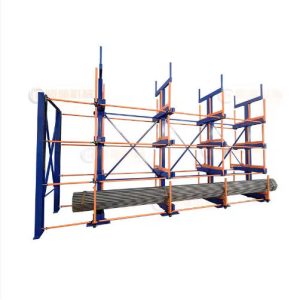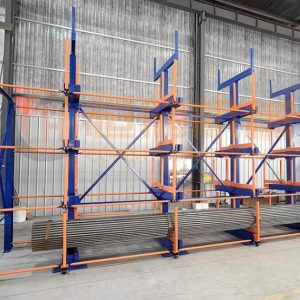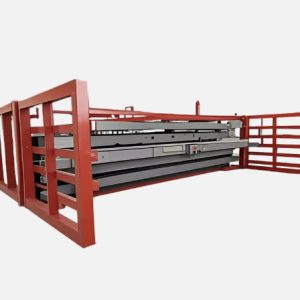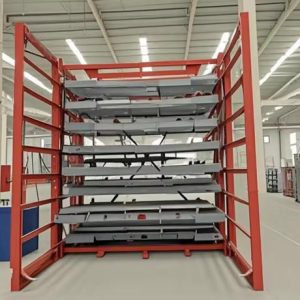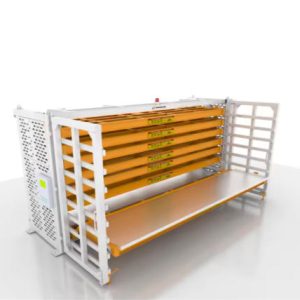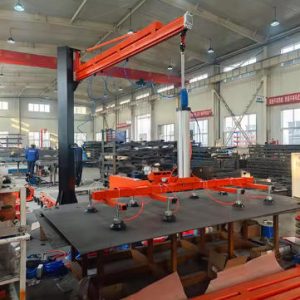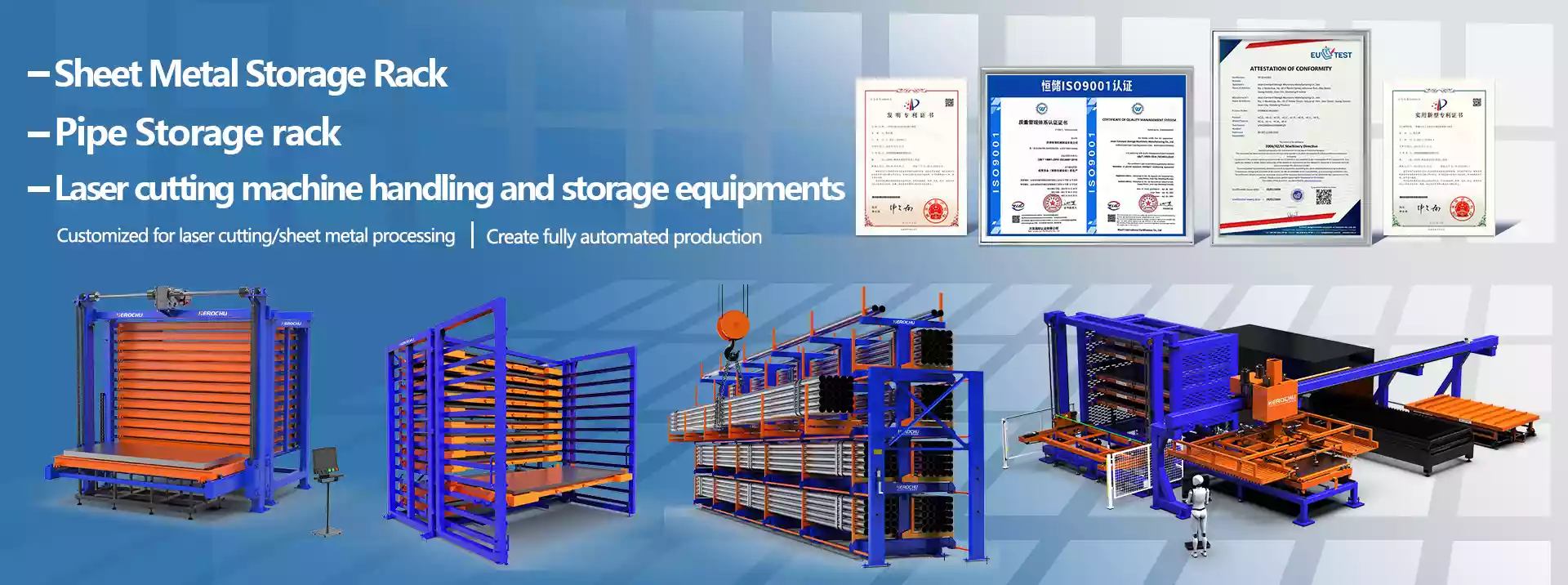
Fabrication shop sheet metal storage rack
The heart is a dry-running, oil-free rotary vane pump driven by 380-440 V, 50/60 Hz single-phase supply. It pulls a clean -85 kPa and stores the reserve in a three-litre tank, so even if someone kicks the mains cable the plate stays locked for a full five-minute coffee break. Pneumatic logic valves switch the circuit—vacuum on, hold, release—so there is no solenoid to stick, no PCB to fry, no summer heatwave to fear. For sites already fed by a 6 bar compressor the same beam can be specified with a venturi cartridge; unplug the motor, screw in the air line, and the lifter keeps working while the electrician is still looking for his screwdriver.
From US $2,689 | CE – UE – ISO 9001 | 24-hour customised drawing | stock frames ship in 7 days
A single operator walks up to a three-ton stack of laser-grade steel, touches a handle, and in the next breath a two-metre panel glides onto the cutting table—no gloves burned on hot slag, no shouting for a second forklift, no scarred edges from C-clamps. That quiet moment is the Herochu pneumatic vacuum lifter doing what it was engineered to do: turn brute weight into fingertip work without asking the workshop to rewire the ceiling or buy a bigger crane.
The heart is a dry-running, oil-free rotary vane pump driven by 380-440 V, 50/60 Hz single-phase supply. It pulls a clean -85 kPa and stores the reserve in a three-litre tank, so even if someone kicks the mains cable the plate stays locked for a full five-minute coffee break. Pneumatic logic valves switch the circuit—vacuum on, hold, release—so there is no solenoid to stick, no PCB to fry, no summer heatwave to fear. For sites already fed by a 6 bar compressor the same beam can be specified with a venturi cartridge; unplug the motor, screw in the air line, and the lifter keeps working while the electrician is still looking for his screwdriver.
Eight or ten suction cups lock to cross-slots on an aluminium extrusion that moves in X and Y. Slide the cups inward and the same frame will pick a 1 250 mm square remnant; slide them outward and it swallows a 4 000 mm skin without adding weight. Cup diameter steps from 200 mm on 300 kg panels to 250 mm on the one-tonner, so thin 8 mm aluminium will not oil-can and heavy 20 mm plate will not sag. Each cup line has its own vacuum sensor: drop below -60 kPa and an amber beacon flashes, the hoist circuit locks, and a 92 dB buzzer reminds everyone to stand clear until pressure rebuilds. Hit the mushroom button and the circuit flips to atmospheric release—plate down, job done, no violent jerk.
The beam itself is a welded box of 5 mm steel skinned with 2 mm aluminium chequer plate to keep mass low. Total weight for a 3 m two-cup beam is 38 kg, so two technicians can shoulder it up a ladder and bolt it to an existing overhead rail in twenty minutes. A bottom-mounted handle pivots 360° on a sealed bearing; the operator can spin the plate to align the grain while walking, elbows never above shoulder height. Ergonomics audits on a three-shift site showed a 28 % drop in reported wrist strain in the first month.
Four stock models cover most laser and plasma tables. The HC-PR3015-300 lifts 300 kg sheets up to 3 m long and 8 mm thick; the HC-PR4020-1000 moves one-ton, 20 mm plate across a 4 m span without growing the outer dimensions. Need to flip the load vertical for edge deburring? Add a 90° powered tilt module driven by a planetary gearbox and pneumatic brake. The rotation locks at any angle, so you can present the plate to a roller table, deburring machine or stillage without a second operator steadying the edge.
Installation is deliberately plug-and-play. A single cable with an industrial CEE plug feeds the on-board inverter; no control cabinet, no star-delta contactors, no programming laptop. Compressed-air models ship with a self-draining filter regulator and a quick-connect Euro coupling—hook up, adjust 6 bar, lift. Every lifter leaves the Jiangsu plant with a full test dossier: 1.5 × rated load held for thirty minutes, leak-down under 2 % per minute, insulation resistance > 100 MΩ. The paperwork travels in the crate so your insurer and ISO auditor tick their boxes before the shrink-wrap hits the skip.
Return on investment arrives faster than the delivery truck. A job shop feeding a 6 kW laser reported an average 3.9 min per sheet using magnets and slings—walk, shim, de-burr where the magnet scarred the edge. With the Herochu vacuum beam the same operator lowered the crane, touched the toggle, lifted and positioned in 42 s. At seventy sheets per day the saving is 4.1 labour hours daily; capital cost is recouped in nine weeks before counting fewer scratches, less edge deformation and the ability to run thinner protective film that used to tear under magnetic claws.
Custom builds are routine. Add a second beam for tandem lifts of composite sandwich panels, specify food-grade blue cups for brushed stainless in a brewery, or request radio remote so the rig can hang from a mobile boom and feed roof sheets three stories up. We keep blank extrusion in stock; unusual lengths ship in five days, not five weeks. Spare parts—cups, filters, sensors—are stocked in Rotterdam, Houston and Dubai for 72-hour delivery, and every component is tool-free replaceable on the shop floor.
Email the longest plate you handle, the thickest and the weight. Within one working day you receive a 3-D drawing, vacuum calculation and freight cost. Approve the design, pay a 30 % deposit and the lifter ships in seven days, ready to cut your handling time in half before the next shift change.
Herochu pneumatic vacuum lifter—grab, lift, breathe.
Q1: What steps should I take to start the procurement process?
You may get in touch with our backend technical staff first. Based on your specific parameters, we will formulate a suitable technical solution and provide a quotation. Alternatively, you can leave your contact details—such as WhatsApp, WeChat, or email address—and our professional sales team will reach out to you proactively.
Q2: How can I inform you of my need for suitable shelves?
You can share key information with us, including the type of items you plan to store on the shelves, the dimensions of those items, the quantity of shelves required, and any other specific details you have. With this information, we will develop a professional solution tailored to your needs. If you prefer, you can also leave your contact information, and our specialized team will contact you to address your questions.
Q3: Should I choose a loading robotic arm or an integrated loading and unloading system?
To determine the right option, two key factors need to be considered first:
- The table size of your laser cutting machine must meet the matching requirements for the equipment.
- We need to know your specific loading method—whether it is a board rack, exchange platform, or material warehouse.
For a more accurate recommendation based on your specific needs, please leave your contact information, and we will provide targeted service.
Q4: Do you offer on-site installation and debugging services?
Yes, we do. We can dispatch professional technicians to your factory to carry out on-site installation and debugging of the robotic arm, and we will continue working until the equipment completes a successful trial operation. Our team has provided such services in many countries, including South Africa, the United States, Russia, South Korea, Qatar, Egypt, Lebanon, and Mexico.
Q5: What measures do you take to ensure product quality?
We have a comprehensive quality assurance system, supported by the following key measures:
- A team of over 40 technical engineers, with professional mechanical engineers responsible for debugging equipment and resolving any technical concerns.
- A dedicated quality inspection department that strictly adheres to ISO9001 quality standards, ensuring all products meet the required quality specifications.
- Professional CE certification, which guarantees smooth export procedures for our products to global markets.
- Mandatory load testing for all equipment before shipment, ensuring the structural safety and operational stability of each product.
Q6: Where is your factory situated?
Our factory is located in Jinan, Shandong Province, China, specifically at No. 10 Industrial Park, Jiyang Street. It features a modern, standard workshop covering an area of 10,000 square meters.
Q7: How can I verify your company’s strength?
We offer two convenient ways for you to assess our company’s capabilities:
- We can arrange a video tour of our factory, allowing you to remotely view our production environment and facilities.
- We warmly welcome you to visit our factory in person for an on-site inspection.
Q8: What type of company are you?
We are Jinan Constant Storage Machinery Manufacturing Co., Ltd., a high-tech enterprise that integrates research and development, production, sales, installation, and after-sales service. Our core product range includes intelligent sheet metal material warehouses, drawer-type sheet metal shelves, telescopic cantilever shelves, servo swing arm manipulators, gantry loading and unloading manipulators, fully automatic loading and unloading systems, and heavy-duty sheet metal and pipe storage shelves. Equipped with a professional technical team and advanced production equipment, we are committed to providing high-quality, high-performance mechanical products and customized solutions to customers around the world.
PRODUCTS
-
Heavy Duty Cantilever Racking System
Cantilever Steel Bar, Tubing & Pipe Storage Racks
Read moreRated 0 out of 5 -
Heavy Duty Cantilever Racking System
Cantilever steel bar tubing & pipe storage racks
Read moreRated 0 out of 5 -
Sheet Metal Storage Racks
Sheet Metal Storage Racks Solve Floor Space Problems
Read moreRated 0 out of 5

